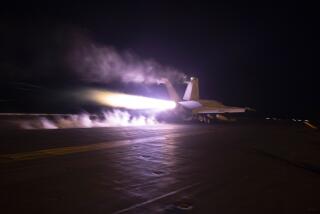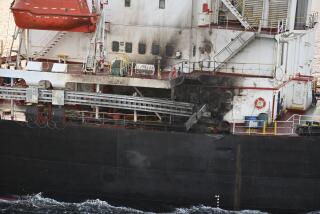Britain, France Shift Policy, Will Send 6 Minesweepers : More Mines Found in Oman Gulf
- Share via
Britain and France today reversed an earlier decision and announced they will send six minesweepers to the Persian Gulf to protect their warships and vessels after the discovery today of four more mines in the area.
Britain earlier had turned down a U.S. request that London send minesweepers into the gulf. But Defense Secretary George Younger stressed that there are no plans for its four minesweepers and one support ship to work with U.S. Navy ships.
“News of further mining in the gulf area over the past 48 hours shows a new situation has arisen there,” Younger told a London news conference.
He declined to speculate on Britain’s response to any future U.S. request for help in the gulf and said of the British minesweeping decision, “I have no doubt that our friends, the Americans, will be very pleased with this.”
In Paris, Defense Minister Andre Giraud said France will send two minesweepers and two support vessels to join its naval squadron heading toward the Persian Gulf region. He told reporters only that the ships will “reinforce” the French naval array in the Indian Ocean.
U.S. and Omani helicopters scoured coastal waters of the Gulf of Oman after four floating mines were found today in an anchorage used by scores of tankers and U.S. warships.
Four Mines Reported
The hastily mounted search operation came hours after an Omani navy scout helicopter spotted three mines and a ship’s crew reported a fourth, according to shipping sources.
The 274,347-ton supertanker Texaco Caribbean struck a mine Monday as it maneuvered to drop anchor eight miles off Fujaira. It was the first such incident in the coastal area about 30 miles south of the Strait of Hormuz, the gateway to the Persian Gulf.
Witnesses said four helicopters were sweeping back and forth at low levels, looking for mines.
“There’s a little bit of panic,” among tanker crews anchored in the offshore waters, a shipping source said.
A diplomatic source said earlier that the United States had responded to an appeal by the Sultanate of Oman for help in locating mines just south of the Strait of Hormuz. The Americans “have agreed and are already helping,” the source said.
America has vowed to keep navigation open in the Persian Gulf, through which about 20% of the non-Communist world’s oil passes.
Source Not Clear
The U.S. Navy assembles its convoys of Kuwaiti tankers in the Gulf of Oman.
The mines’ origin was not clear. Some shipping experts said they may have been planted by Iran, or drifted from the Strait of Hormuz, where Iran conducted military exercises last week.
However, a shipping official based in Kuwait said coastal currents move from the Gulf of Oman toward Hormuz in this season.
Meanwhile today, a convoy of three reflagged Kuwaiti tankers under U.S. Navy escort reached Kuwaiti waters “with no further incidents,” said Robert Sims, chief spokesman at the U.S. Defense Department.
Sims said in Washington that as of 4:35 p.m. Kuwaiti time, the tankers were “in Kuwaiti territorial waters . . . under escort by Kuwaiti ships.”
Shipping sources in the Persian Gulf said the convoy had slowed or stopped at mid-afternoon about 60 miles short of its goal in its 550-mile voyage up the gulf, Kuwait’s Al Ahmadi oil terminal. The three Kuwaiti tankers later left their U.S. Navy escorts and entered Kuwaiti waters on their way toward Kuwait’s main oil terminal complex, the sources said.
The most likely reason for the mid-afternoon delay was another mine scare in the area, the sources said.
More to Read
Sign up for Essential California
The most important California stories and recommendations in your inbox every morning.
You may occasionally receive promotional content from the Los Angeles Times.












